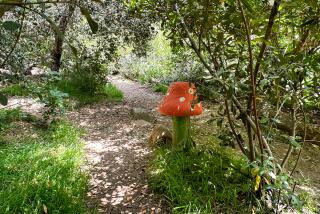Huntington’s Gardeners: The Job Grows on Them
When Jim Folsom pauses at the top of the Japanese Garden at the Huntington Botanical Gardens in San Marino, his experienced eyes aren’t drawn to the vermilion bridge or the gently drooping willow tree, to the flowing stream or the gnarled evergreens. Folsom, 35, assistant curator for the gardens, has eyes only for the shrubbery. “We’ve got to do something here,” Folsom lamented. “That nandina looks awful. People keep stepping in it.”
Folsom and the other botanical employees at the Huntington are always looking for problems in the 12 separate gardens that comprise the Huntington Botanical Gardens. “Looking with a critical eye is part of our job,” Folsom said. “We go out looking for the faults, and to us they stand out like missing teeth. . . . I think it is that attention to detail that makes the difference, that makes the gardens look so good to the public.”
Visitors to the garden are seldom aware of the work that goes into maintaining the 140 acres open to the public. Work crews do the bulk of their gardening before the gates open at 1 p.m., or on Monday when the gardens are closed to the public.
It takes 65 botanical employees to keep the gardens looking good. There are dozens of gardening crew members who perform the day-to-day gardening tasks, six head gardeners in charge of the six major gardens, one grounds supervisor who oversees all the workers, a nursery manager responsible for the Huntington’s huge on-site nursery, two botanists who perform some of the scientific work, a curator who oversees the total operation and sets policy, and an assistant curator, Folsom, who helps set and implement policy.
To keep the operation running smoothly, meetings are held three times weekly with Kimnach, Folsom, and Fred Brandt, the garden superintendent, to discuss projects and problems.
Concerns voiced in the meeting are transmitted to the head gardeners and the crews by Brandt, who keeps track of every project in progress on the grounds. “I’m the inside man,” Kimnach said. “I sit at my desk and handle things. (Brandt) is the outside man. He’s the one who coordinates the day-to-day maintenance of the gardens.”
Kimnach said the other mainstays of the gardens are the six head gardeners. Each head gardener oversees one of the major gardens on the grounds, planning new plantings, and directing work crews in their areas. “Each of our head gardeners is an expert in his field,” Kimnach said. “They have a great deal of independence in their gardens.”
Advance Planning
Planning for the gardens is done months or even years in advance. Many of the specimens for future planting are grown in the large nursery behind the Herb Garden, in an area closed to visitors.
Changes on the ground are planned to occur unobtrusively. Someday, for example, the staff wants to expand the Australian Garden, and re-route traffic through it. To that end, Folsom and a staff botanist recently went out and tramped out tentative new paths through the area. Now they are planting specimens along the proposed pathways, so that in four or five years, when the paths are actually finished, the landscaping will be in place.
To complicate things further, the gardens exist only partly for their beauty. They also exist for research. “It’s much easier to landscape a garden, if that’s all you’re trying to do,” Folsom said. “But we’re always pushing our limits--trying plants that have never been tried in Southern California and may not make it here.”
The gardens receive seed catalogues from botanical gardens throughout the world. Staff members interested in trying a certain plant try to introduce the plant to the garden. “Many of the seeds never germinate or don’t make it in the garden. But we keep trying,” Kimnach said.
In its role as a research institution, thorough records are kept. Index cards are maintained on most plants in the gardens, detailing where the plant or seed was obtained, when and where it was planted, and any problems the plant has encountered.
If a plant dies, its card is not discarded, but rather moved to a section of the file cabinets the staff calls “Plant Heaven” so future researchers can try to pinpoint problems with growing particular plants. To date, more than 54,000 plants or seed batches have been catalogued at the Huntington.
There are, of course, occasional problems at the gardens. Take the recent case of Tetraclinis articulata, an undistinguished-looking conifer Kimnach has been trying for years to introduce to the gardens.
Plant Heaven chronicles Kimnach’s failures. File cards indicate that Tetraclinis seeds were obtained 10 times between 1965 and 1983. The seeds came from around the globe--from the Canary Islands, from Malta, from Moscow. Most of the cards contain the simple notation, “failed to germinate.” Another says, “One seedling germinated, died in lath house due to improper watering.” Finally in 1978, some seed obtained from the Los Angeles County Arboretum germinated and was eventually planted in the Australian Garden where it was doing well.
Until now. On a recent Monday, botanist Kathy Musial reported to the staff the most recent Tetraclinis a failure. The Tetraclinis in the Australian Garden is gone, she said. One of the gardeners had apparently mistakenly removed the plant.
Kimnach is philosophical. “We’ll start some more seeds and try again. The garden will be here for a long time, and sometime we’ll have a Tetraclinis plant,” he said.







